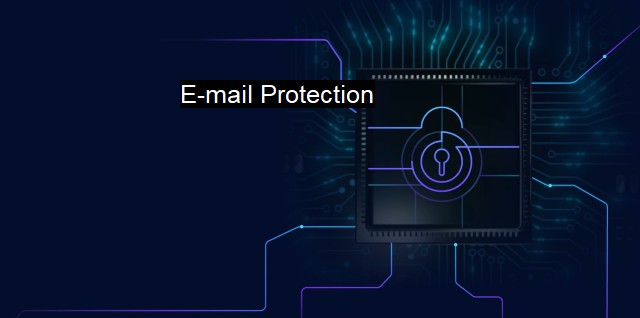What is E-mail Protection?
Securing Email Communications: Understanding Email Protection in the Face of Rising Cyber Threats
E-mail protection is a crucial aspect of cyber security and antivirus mechanisms. With more and more people worldwide regularly utilizing an email for personal use or work-related purposes, protecting the information circulated through emails is of paramount importance. A deeper look into the nuances and functions of e-mail protection might provide us an ideal understanding of this topic’s relevance in today’s world.Simply put, e-mail protection is a set of software processes designated to secure and protect email communications from threats such as phishing, spoofing, malware, ransomware, and more. These protection methods come in several forms, the most prevalent forms being firewalls, email filters, and antivirus programs. They can function automatically, scanning and filtering incoming and outgoing mail. These technologies often learn from historical data to identify common patterns associated with suspicious mail, thus constantly adapting and improving their protective features.
An integral part of e-mail protection is secure email gateways. These work as the first line of defense and are implemented to filter out large volumes of phishing emails, spam, and other threats before reaching the user’s mailbox.
An essential component of e-mail protection is the identification and blockage of phishing emails and spoofed email addresses, both of which exploit trust to extract confidential information from unsuspecting users. Phishing often includes socially engineered email content aimed at tricking the recipient into revealing sensitive data like passwords or credit card details, while spoofing involves disguising malicious emails as trustworthy sources.
Another significant threat targeting emails is malware. Short for malicious software, it represents a variety of harmful programs, including viruses, trojans, worms, ransomware, and more. They may come as attachments in an email and may cause substantial damage to data and systems if downloaded and executed. Leading antivirus products dominate the forefront of e-mail protection against malware threats. They often use complex algorithms to detect and isolate known and unknown forms of malware.
Ransomware, a specific type of malware, has become increasingly prevalent. This malevolent program takes over the user's data or the system itself and demands a ransom in exchange for returning user control. Erstwhile versions have spread through malicious email links and attachments; hence, robust e-mail protection practices are vital to safeguard against ransomware threats.
Spam Mail, often considered a mere nuisance due to its bulk and irrelevant content, can be a vehicle for severe threats. These unsolicited bulk emails may carry viruses or links that direct to malicious websites. Consequently, email filters in e-mail protection help reduce exposure to such risks by analyzing each email’s content and blocking those identified as Spam.
Securing email transactions lies at the heart of e-mail protection services. Secure MIME (S/MIME) and DomainKeys Identified Mail (DKIM) are examples of email authentication methods that help protect the email content, verify the email sender's identity, and ensure that the email is not altered during transmission.
e-mail protection and cybersecurity play an essential role in defending against the part of the ever-growing landscape of digital threats targeting email communications. In consideration of various email borne security risks evident in the present digital era, defense mechanisms such as firewalling, spam filtering, phishing prevention, and antivirus software are becoming increasingly important in our virtual environment. By understanding and utilizing such protective measures, users and businesses can significantly mitigate email-related cyber threats, ensuring the safe transportation of data and information via email.

E-mail Protection FAQs
What is e-mail protection and why is it important for cybersecurity?
E-mail protection refers to the security measures implemented to protect email communication from cyber threats. With the increase in cyber attacks and email being a primary means of communication, it is essential to have e-mail protection to prevent phishing attempts, malware infections, and other cyber threats.What are some common e-mail protection measures?
Common e-mail protection measures include spam filters, antivirus software, firewalls, email encryption, and two-factor authentication. These measures help to detect and block malicious emails, prevent unauthorized access, and ensure secure communication.How does antivirus software contribute to e-mail protection?
Antivirus software scans emails and attachments for potential malware or viruses, blocking any malicious content from being delivered or accessed. It helps to prevent phishing attacks through attachment scanning and link analysis, giving users a warning when they click on suspicious links. It also provides real-time protection against zero-day threats, ensuring that your system is always up-to-date with the latest security patches.What are some best practices for enhancing e-mail protection?
Some best practices for enhancing e-mail protection include avoiding clicking on links or downloading attachments from unknown senders, using strong passwords with two-factor authentication, regularly updating antivirus software and firewalls, and installing security updates and patches as soon as they become available. Employees should also undergo regular cybersecurity training to identify and mitigate potential threats.| | A | | | B | | | C | | | D | | | E | | | F | | | G | | | H | | | I | | | J | | | K | | | L | | | M | |
| | N | | | O | | | P | | | Q | | | R | | | S | | | T | | | U | | | V | | | W | | | X | | | Y | | | Z | |
| | 1 | | | 2 | | | 3 | | | 4 | | | 7 | | | 8 | | |||||||